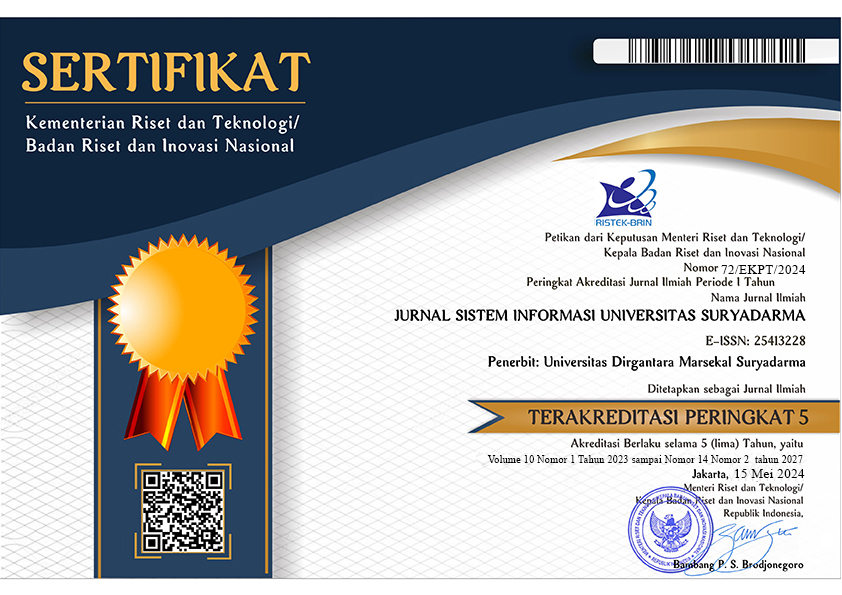
Pengaruh Structural Assurance Dan Trust Terhadap Online Purchase Intention Pada Sistem Penjualan E–Commerce Perusahaan Xyz
Sari
The Covid-19 pandemic has made the digital era develop rapidly, as well as e-commerce, the purchase process can be done from home, digital marketplace media facilitate users with interactive applications that can be called very responsive. PT XYZ, which usually conducts transactions in a traditional way, also has to keep up with developments. However, there are problems with the level of security and customer trust in e-commerce transactions. From the company's graphic data, it shows that customer loyalty has not been well developed.From the Structural Assurance variable at PT XYZ, where thitung is greater than ttable 5.315 > 1.667, due to the response from the sales admin who is very responsive to questions from customers from the Trust variable thitung is greater than ttable 2.816 > 1.667, needs to be improved, socialization about the company through digital media such as the web and non-digital media such as offline stores. From the simultaneous test, Fhitung is greater than Ftable 13.652 > 3.130. This shows that there is a significant influence of Structure Assurance and Trust together on Online Purchase Intention at PT XYZ
Teks Lengkap:
PDFReferensi
Belch, G.E dan Belch, M.A. (2007). Advertising and Promotion: An Integrated marketing communication perspective, 7th ed. McGraw-Hill. New York.
Fitra, Dharma. 2006. “Pengaruh Structural Assurance dan Perceived Reputation Terhadap Trust Pengguna Internet di Sistem E-commerce”, Jurnal Simposium Nasional Akuntansi, IX.
Ghozali, Imam, 2018. Aplikasi Analisis Multivariate dengan Program IBM SPSS 25. Badan Penerbit Universitas Diponegoro. Semarang.
Hwang, Y., dan Kim, J. 2006. The Effects of Perceived Web Quality With Service Content on Enjoyment, Anxiety, and E-trust (online)
https://tekno.kompas.com/read/2022/09/06/21193067/105-juta-data-kependudukan-warga-indonesia-diduga-bocor-diklaim-dari-kpu?page=all
Koltler, Philip (2008). Marketing Management 13th edition.
Krisnawati, Elfina Y. 2010. “Analisis Perbedaan Tingkat Intensi Membeli Melalui Media Internet (Online Shopping) Ditinjau dari Tipe Gaya Hidup pada konsumen Pengguna Internet”, Skripsi, Universitas Airlangga. Surabaya.
Maholtra, N.K., Kim, S. S., and Argawal, J. (2004). “Internet users’ information privacy concerns (IUIPC): The construct, the scale, and a causal model.” Information System Research, 15(4), 336-355.
Marlien, Probo R.A. (2010), “Pengaruh Reputasi, Privasi dan Keamanan Terhadap Kepercayaan (Trust) Pengguna Internet di Semarang dalam Sistem E-Commerce”, Skripsi, Universitas Stikubank. Semarang.
McKnight, D.H., Choudhury, V.,& Kacmar, C. 2002. Developing and Validating Trust Measures foe e-Commerce: An Integrative Typology.
Pavlou, Paul A. (2003), Consumer Acceptance of Electronic Commerce: Integrating Trust and Risk With The Technology Acceptance Model. International Journal of Electronic Commerce, Spring 101-134.
Raharja, R. A., Yunianto. A., Widyantoro W. (2001), Modul Pelatihan Administrasi Jaringan Linux. Open Source Campus Agreement.
Santoso, Singgih. 2011, “Mastering SPSS Versi 19”. Jakarta : PT Elex Media Komputindo.
Sugiyono. 2008. Metode Penelitian Pendidikan. Bandung : Alfabeta.
Sugiyono. 2011. Metode Penelitian Pendidikan. Bandung : Alfabeta.
Suyanto, M. 2003. Strategi Periklanan Pada E-Commerce Perusahaan Top Dunia. Yogyakarta : Andi Offset.
Turban, Efraim dan Lee, M. K. O. 2001. A Trust Model for Consumer internet Shopping. International Journal of Electronic Commerce. Vol 6, No. 1, pp. 75-91.
Wilkinson, W.J., Cerullo. J.M., Raval. V., Wong-on-Wing. B. (2000), Accounting Information Systems. Fourth Edition, John Wiley and Sons. Inc.
Wong, J. 2010. Internet Marketing For Beginners. Jakarta : PT. Elex Media Komputindo
DOI: https://doi.org/10.35968/jsi.v10i1.994
Refbacks
- Saat ini tidak ada refbacks.
Indexed by:





